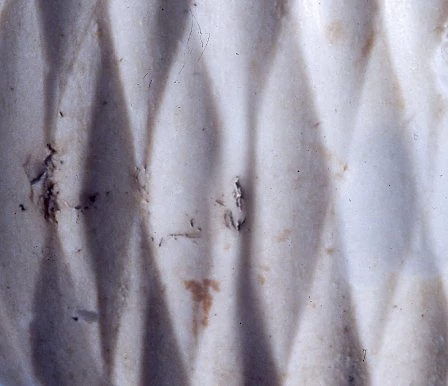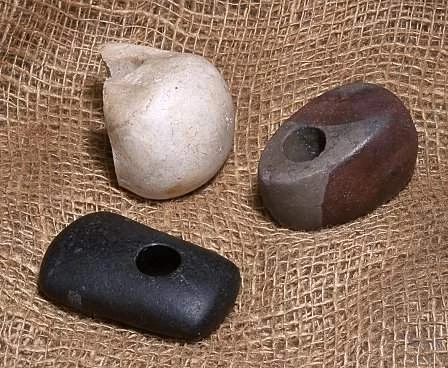Pen brysgyll Maesmor - un o gampweithiau Oes y Cerrig
Pen brysgyll Maesmor.
Wedi'i ddarganfod yn 1840, arferid credu bod y gwrthrych hwn naill ai'n forthwyl aberthol Archdderwydd, neu'n frysgyll rhyfel a oedd yn eiddo i bennaeth Celtaidd.
Manylyn o'r cerfwaith ar ben brysgyll Maesmor, sy'n dangos nam anghyffredin yn y cynllun, sef dau gwplws wedi'u torri (gweler canol y llun).
Pennau brysgyll o Gwm Ogwr (Bro Morgannwg), Y Fron (Sir y Fflint), a Thŷ'r Sger (Pen-y-bont ar Ogwr). Mae'r rhan fwyaf o'r pennau brysgyll a luniwyd tua 2500CC yn gymharol syml a diaddurn. Cafwyd hyd i enghreifftiau tebyg i hwn ledled Cymru.
Mae'n hawdd meddwl am Oes y Cerrig fel cyfnod pan oedd bywyd yn fyr, yn greulon ac yn fwystfilaidd. Mae pen brysgyll Maesmor yn brawf nad felly yr oedd hi drwy'r amser.
Arferid gweithio pennau brysgyll fel hwn tua 2500CC, cyn bod sôn am drin metel ac ar adeg pan oedd cymunedau yn ennill eu bywoliaeth drwy ffermio'r tir gyda chymorth offer cerrig.
Cafwyd hyd i nifer o bennau brysgyll yng Nghymru. At ei gilydd, fe'u darganfuwyd yn ddamweiniol, wedi i ryw weithgaredd eu dwyn i'r golwg gerllaw'r fan lle cawsant eu colli neu eu gwaredu. Fodd bynnag, fe'u ceir weithiau mewn claddiadau, gan gynnwys un enghraifft o Wiltshire y cafwyd hyd iddo ar bwys corff oedd wedi'i addurno ag addurniadau aur ac asgwrn.
Mae hyn wedi arwain at yr awgrym bod pennau brysgyll yn symbolau o rym – gwrthrychau a roddai statws i'w perchennog. Mae'n hawdd dychmygu mai dyna beth oedd y pen brysgyll hwn, oherwydd pe bai ei berchennog am gael rhywbeth i'w ddefnyddio fel pastwn yn unig, byddai wedi arbed llawer iawn o ffwdan iddo ef ei hunan drwy dyllu carreg a'i gosod ar ben coes bren.
Yn lle hynny, cymerodd ddarn mawr o gallestr wen – sydd yn anghyffredin yn Sir Ddinbych lle cafwyd hyd i'r pen brysgyll – gan ei naddu a'i braslunio. Yna, tyllwyd y garreg galed, gan ddefnyddio, yn ôl pob tebyg, ddril bwa ynghyd â llawer o ddŵr a thywod i'w helpu i greu'r twll ar gyfer y goes.
Ond y gamp oedd torri a chaboli'r ffasedau ar ochrau'r pen brysgyll er mwyn creu'r cynllun cywrain. Cyflawnwyd hyn hefyd, yn ôl pob tebyg, drwy ddefnyddio ochr dril bwa i greu'r rhigolau sy'n gorgyffwrdd â'i gilydd.
Mae'n swnio'n waith digon rhwydd ond mae'n rhaid bod gwneuthurwr y pen brysgyll hwn wedi bod wrthi am ddegau o oriau.
Y canlyniad yw pen brysgyll hardd sydd wedi goroesi mil o flynyddoedd, gwrthrych oedd yn destun edmygedd ei berchennog – efallai hynafgwr neu bennaeth cymuned, neu grefftwr cyffredin a ymfalchïai yn ei allu ef ei hun.
Pwy bynnag oedd yn berchen ar ben brysgyll Maesmor, mae'n dangos y bu adegau, hyd yn oed yn ystod Oes y Cerrig, pan gâi celfweithiau eu creu a'u gwerthfawrogi.



sylw - (13)
I have since my last comment completed a flint mace of this type based on the Knowth mace from NewGrange in Ireland, I have yet to conquer a copy of the Maesmor head but it is on my to do list. I would be happy to email you some pictures of my Knowth mace and answer any questions about its production and the hurdles working with flint throws at you when working with it to make these things.
Hi,
Thanks for your comment Skot, you make a fair point, the grind marks do run down the grooves. A few experimental archaeologists have looked at this macehead over the years with the intention of having a go at replicating elements of the design but I'm not aware of anyone who's actually done so. We'd be delighted if you tried and would love to hear how you get on.
Kind regards,
Steve Burrow
(Head of Historic Properties)
I am currently working on some recreations of this technique on stone maces and hope to carve a flint one soon, that way i can experiment and get a clearer picture of how this may have actually been done.
The Maesmawr macehead and the example from Knowth in Ireland date to the late Neolithic (c.3000-2500BC) and are remarkably similar in material, form and decoration.
Maceheads with this ovoid shape and faceted decoration are known as Maesmawr type and the few examples that are known are distributed across Britain from Windmill Hill in Wiltshire, to Sutherland in Scotland. These incredibly fine prestige objects are made from flint which has been shaped and polished before carefully grinding out the lozenge shaped facets.
Most of the known examples of Maewmawr type maceheads are antiquarian finds from uncertain contexts but those maceheads that do have good contexts show that they are rarely found with burials and probably have another type of ceremonial role in Later Neolithic life.
George Eogan and Hilary Richardson, who in 1982 reported on the discovery of the Knowth macehead in the Journal of the Royal Society of Antiquaries of Ireland, believed the relief decoration of spirals and curved demonstrated that it was not an import from Britain but an Irish take on the Maesmawr form.
Hi there Adam, thanks for your comment. It really is such a beautiful object, and it would be interesting to know whether there is a connection with the Knowth mace head.
I'll pass on your comment to our curators and post their reply when I get it.
Thanks again for your enquiry
Sara
Digital Team